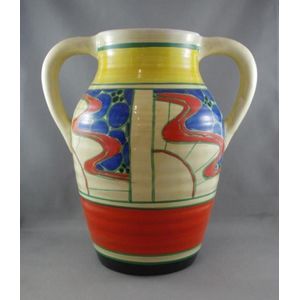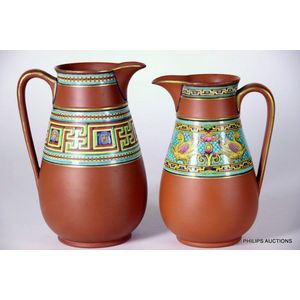Prattware Terracotta Jugs with Roman Borders
Two Prattware terracotta jugs, mid 19th century, the pear-shaped jugs in two sizes with wide friezes of Roman borders in polychrome enamel enamels below a proud gilded ring and geometric bands to the rim; unmarked to one, the other with a trio of green dots, Heights: 16.5 cm, and 15.5 cm
You must be a subscriber, and be logged in to view price and dealer details.
Subscribe Now to view actual auction price for this item
When you subscribe, you have the option of setting the currency in which to display prices to $Au, $US, $NZ or Stg.
This item has been sold, and the description, image and price are for reference purposes only.
- Polychrome - Made or finished in many colours. For furniture, it is used to indicated a painted finish.
- Gilding - Gilding is a method of ornamentation whereby a thin sheet of gold metal is applied to items made of wood, leather, ceramics, glass and silver for decorative purposes.
For furniture including mirrors, the sheet of gold is usually applied over a coating of gesso. Gesso is a mixture of plaster of Paris and gypsum mixed with water and then applied to the carved wooden frames of mirrors and picture frames as a base for applying the gold leaf. After numerous coats of gesso have been applied, allowed to dry and then sanded a coat of "bole", a usually red coloured mixture of clay and glue is brushed on and allowed to dry, after which the gold leaf is applied. Over time parts of the gilding will rub off so the base colour can be seen. In water gilding, this was generally a blue colour, while in oil gilding, the under layer was often yellow. In Victorian times, gilders frequently used red as a pigment beneath the gold leaf.
Metal was often gilded by a process known as fire gilding. Gold mixed with mercury was applied and heated, causing the mercury to evaporate, the long-term effect of which was to kill or disable the craftsman or woman from mercury poisoning. The pursuit of beauty has claimed many victims, not the least of which were the artists who made those pieces so highly sought after today. - Terracotta - Terracotta is lightly fired earthenware, red or reddish-brown in colour, used in ancient times. Fired at higher temperatures terracotta was used in the nineteenth century for decorative vases and similar objects, but rarely for utilitarian goods. Other uses for terracotta include roofing tiles, garden pots and ornaments. Glazed terracotta is known as faience.
This item has been included into following indexes:
Visually similar items

Mirek Smisek, set of four mugs, incised signature mark, 10 cm heights
Sold by
in
for
You can display prices in $Au, $US, $NZ or Stg.

Four pieces of Torquay 'motto ware', to include a hot water pot, milk jug coffee cup,and a tri footed vase
Sold by
in
for
You can display prices in $Au, $US, $NZ or Stg.

Clarice Cliff 'Fantasque' Isis vase, 2 handled, Sunrise pattern, 25 cm high
Sold by
in
for
You can display prices in $Au, $US, $NZ or Stg.

Wedgwood Keith Murray tankard. Green glaze. Height 12 cm
Sold by
in
for
You can display prices in $Au, $US, $NZ or Stg.
